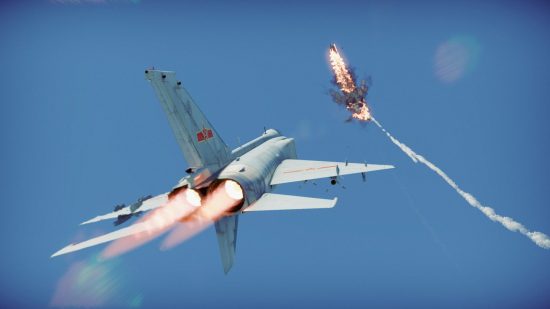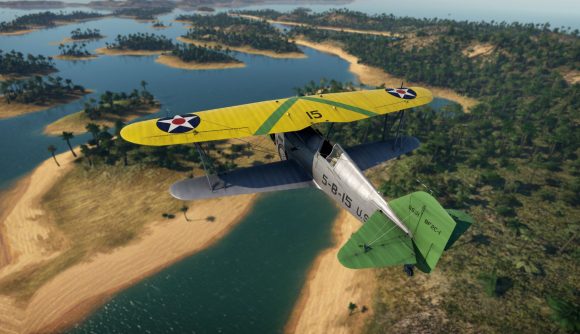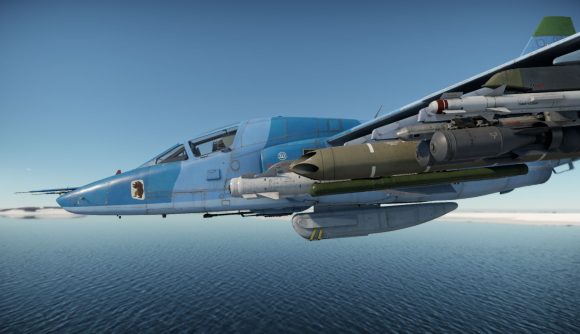The element of choice in War Thunder is what makes it such an enduring favorite among war game aficionados. With plenty of ground and sea force options, you can grind along the ground in massive armored tanks, or engage in great naval battles across wide expanses of sea. Sometimes though, you just crave that feeling of soaring through the sky – which is where this guide comes in.
War Thunder veterans will already be aware of the sizable La Royale update that has enriched the game with new mechanics, locations, missions, graphical updates, and of course, the most exciting element – new tanks, planes, boats, and helicopters. What better time to take to the skies than now, when a dozen new aircraft have been added alongside the updated challenge of anti-aircraft flight physics and refined effects for rockets and missiles.
We’ve put together a quick guide to get you into the cockpit and trying out some of these powerful new machines, so read on for our beginner’s guide to everything aviation in War Thunder.
Aircraft accuracy
If you’re not already an aviation geek, you will be once you catch the War Thunder bug. An equal amount of effort has been put into creating accurate historical machines as has gone into the actual feel of battle, producing a series of familiar designs that look and handle like the real thing. From unusual variants like the Tandem MAI, an obscure experimental Soviet aircraft, to classic icons of warfare like the Spitfire, you’ll be able to boost your knowledge of real-world planes while learning the quirks of those in-game. If you already know your onions, you’ll find some of that knowledge will help you strategize for the best plane pick.
Some of the newest additions in the La Royale update include the new reserve machine – the BF2C-1 biplane – along with the Su-25T and Su-39, J8F, and Mirage 2000 5F, but the biggest name goes straight to the top-tier in the American tech tree – the F-14B naval jet.
If none of these letters and numbers mean anything to you, don’t panic, next we’ll go through plane types and how best to use them.
Aircraft in War Thunder come, as in real life, in three main categories: bombers, fighters, and attackers. Within these categories are a number of sub-sections, and a few jack-of-all-trades machines that can act in multiple roles during even the most heated battles.
Bombers
Bombers are identified in the game by a blue name tag, and their main purpose is to drop things – namely, bombs and torpedoes – with each subclass handling combat differently. For now, don’t worry about the less defined categories like naval bombers, jet bombers, and frontline bombers, instead focus on the following three to really hone your aerial skills.
Medium and heavy bombers – like the B-34 or B-17E Flying Fortress – operate from a fairly high altitude, allowing you to aim through a bombsight reticle. Arcade Mode is best for practicing this technique as it also shows a crosshair at the point at which your bomb should land, showing you the importance of steady flight when teeing up a drop. These bombers are far from nimble, however, so you’ll want to keep flying high and using smaller, lower teammates for cover if possible.
Dive bombers, like the Ar-2, are pretty much the opposite. Instead of looking to level out before dropping bombs, you’ll want to refine a technique that has you diving to release them on a target. The more steep the dive angle, the better your accuracy will be, making these a great option for delicate missions or quick drops.
Finally, you’ve got torpedo bombers, which actually don’t bomb at all, but rather fire torpedoes into the sea. These bombers, like the aptly named Swordfish, give you a bright green line that shows where the torpedo will drop, but you’ll have to level out at a fairly low altitude, meaning you’ll be vulnerable to passing ships during naval warfare.
Fighters
Fighters display their names in a fetching orange color and are perfect picks for when the battlefield is filled with other planes. They work best against aerial threats and tend to be both speedy and stealthy. The new J-8F, for example, from the La Royale update, is a famous Chinese jet fighter, equipped with helmet-mounted sight and advanced weapons. This plane heads straight to the top tier of the Chinese tech tree.
Heavy fighters are the bigger brother of the fighter, a beefier machine with a bigger overall presence. They’re less maneuverable and agile, but they pack a serious punch during combat. You might not want to set one of these against the more nimble fighter, but it would do well against equally sized aircraft like a medium or heavy bomber – especially if the pilot is preoccupied with other things, like dropping bombs.
Attackers
Attackers are best placed for assault from above – focusing their artillery efforts on things crawling along the ground, i.e. tanks, or stationary anti-aircraft batteries. They can bomb and dive like bombers, or speed along firing cannons and rockets, making this a fairly wide-ranging class of military aircraft.
Light bombers, despite the name, are included in this class because of their flexibility, although they were mainly phased out in the real world by improvements to fighter planes. Joining the roster with the La Royale update is the Russian Su-25T and Su-39, a pair of anti-tank aircraft that boast high-precision weapons and navigation systems that can easily be used during the day or night.
The best way to become acquainted with the aircraft in War Thunder is to pick one of each category and throw yourself into the pilot’s seat. It’s up to you to find out whether you prefer the heavy and imposing might of a bomber or the swift attack ability of the fighter. Start playing War Thunder on PC today, and explore what the new La Royale update has in store. If you’re looking for more War Thunder content, check out our guides on land battles and sea battles.





